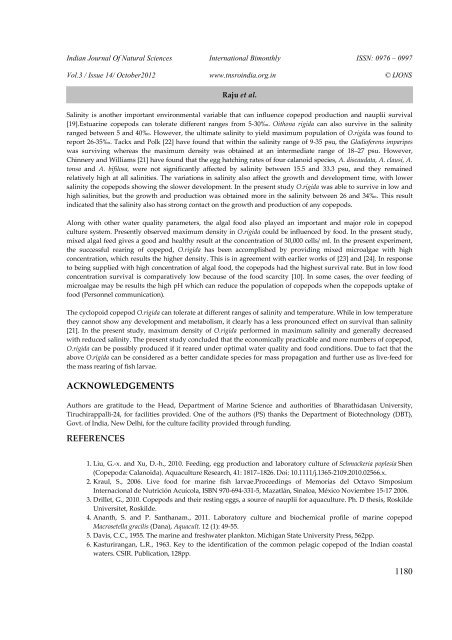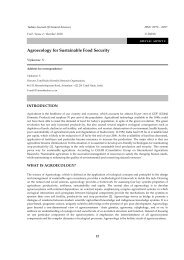Seismic Analysis of RC Frame Structure with and ... - tnsroindia.org.in
Seismic Analysis of RC Frame Structure with and ... - tnsroindia.org.in
Seismic Analysis of RC Frame Structure with and ... - tnsroindia.org.in
You also want an ePaper? Increase the reach of your titles
YUMPU automatically turns print PDFs into web optimized ePapers that Google loves.
Indian Journal Of Natural Sciences International Bimonthly ISSN: 0976 – 0997<br />
Vol.3 / Issue 14/ October2012 www.<strong>tnsro<strong>in</strong>dia</strong>.<strong>org</strong>.<strong>in</strong> © IJONS<br />
Sal<strong>in</strong>ity is another important environmental variable that can <strong>in</strong>fluence copepod production <strong>and</strong> nauplii survival<br />
[19].Estuar<strong>in</strong>e copepods can tolerate different ranges from 5-30‰. Oithona rigida can also survive <strong>in</strong> the sal<strong>in</strong>ity<br />
ranged between 5 <strong>and</strong> 40‰. However, the ultimate sal<strong>in</strong>ity to yield maximum population <strong>of</strong> O.rigida was found to<br />
report 26-35‰. Tackx <strong>and</strong> Polk [22] have found that <strong>with</strong><strong>in</strong> the sal<strong>in</strong>ity range <strong>of</strong> 9-35 psu, the Gladi<strong>of</strong>erens imparipes<br />
was surviv<strong>in</strong>g whereas the maximum density was obta<strong>in</strong>ed at an <strong>in</strong>termediate range <strong>of</strong> 18–27 psu. However,<br />
Ch<strong>in</strong>nery <strong>and</strong> Williams [21] have found that the egg hatch<strong>in</strong>g rates <strong>of</strong> four calanoid species, A. discaudata, A. clausi, A.<br />
tonsa <strong>and</strong> A. bifilosa, were not significantly affected by sal<strong>in</strong>ity between 15.5 <strong>and</strong> 33.3 psu, <strong>and</strong> they rema<strong>in</strong>ed<br />
relatively high at all sal<strong>in</strong>ities. The variations <strong>in</strong> sal<strong>in</strong>ity also affect the growth <strong>and</strong> development time, <strong>with</strong> lower<br />
sal<strong>in</strong>ity the copepods show<strong>in</strong>g the slower development. In the present study O.rigida was able to survive <strong>in</strong> low <strong>and</strong><br />
high sal<strong>in</strong>ities, but the growth <strong>and</strong> production was obta<strong>in</strong>ed more <strong>in</strong> the sal<strong>in</strong>ity between 26 <strong>and</strong> 34‰. This result<br />
<strong>in</strong>dicated that the sal<strong>in</strong>ity also has strong contact on the growth <strong>and</strong> production <strong>of</strong> any copepods.<br />
Along <strong>with</strong> other water quality parameters, the algal food also played an important <strong>and</strong> major role <strong>in</strong> copepod<br />
culture system. Presently observed maximum density <strong>in</strong> O.rigida could be <strong>in</strong>fluenced by food. In the present study,<br />
mixed algal feed gives a good <strong>and</strong> healthy result at the concentration <strong>of</strong> 30,000 cells/ ml. In the present experiment,<br />
the successful rear<strong>in</strong>g <strong>of</strong> copepod, O.rigida has been accomplished by provid<strong>in</strong>g mixed microalgae <strong>with</strong> high<br />
concentration, which results the higher density. This is <strong>in</strong> agreement <strong>with</strong> earlier works <strong>of</strong> [23] <strong>and</strong> [24]. In response<br />
to be<strong>in</strong>g supplied <strong>with</strong> high concentration <strong>of</strong> algal food, the copepods had the highest survival rate. But <strong>in</strong> low food<br />
concentration survival is comparatively low because <strong>of</strong> the food scarcity [10]. In some cases, the over feed<strong>in</strong>g <strong>of</strong><br />
microalgae may be results the high pH which can reduce the population <strong>of</strong> copepods when the copepods uptake <strong>of</strong><br />
food (Personnel communication).<br />
The cyclopoid copepod O.rigida can tolerate at different ranges <strong>of</strong> sal<strong>in</strong>ity <strong>and</strong> temperature. While <strong>in</strong> low temperature<br />
they cannot show any development <strong>and</strong> metabolism, it clearly has a less pronounced effect on survival than sal<strong>in</strong>ity<br />
[21]. In the present study, maximum density <strong>of</strong> O.rigida performed <strong>in</strong> maximum sal<strong>in</strong>ity <strong>and</strong> generally decreased<br />
<strong>with</strong> reduced sal<strong>in</strong>ity. The present study concluded that the economically practicable <strong>and</strong> more numbers <strong>of</strong> copepod,<br />
O.rigida can be possibly produced if it reared under optimal water quality <strong>and</strong> food conditions. Due to fact that the<br />
above O.rigida can be considered as a better c<strong>and</strong>idate species for mass propagation <strong>and</strong> further use as live-feed for<br />
the mass rear<strong>in</strong>g <strong>of</strong> fish larvae.<br />
ACKNOWLEDGEMENTS<br />
Authors are gratitude to the Head, Department <strong>of</strong> Mar<strong>in</strong>e Science <strong>and</strong> authorities <strong>of</strong> Bharathidasan University,<br />
Tiruchirappalli-24, for facilities provided. One <strong>of</strong> the authors (PS) thanks the Department <strong>of</strong> Biotechnology (DBT),<br />
Govt. <strong>of</strong> India, New Delhi, for the culture facility provided through fund<strong>in</strong>g.<br />
REFERENCES<br />
Raju et al.<br />
1. Liu, G.-x. <strong>and</strong> Xu, D.-h., 2010. Feed<strong>in</strong>g, egg production <strong>and</strong> laboratory culture <strong>of</strong> Schmackeria poplesia Shen<br />
(Copepoda: Calanoida). Aquaculture Research, 41: 1817–1826. Doi: 10.1111/j.1365-2109.2010.02566.x.<br />
2. Kraul, S., 2006. Live food for mar<strong>in</strong>e fish larvae.Proceed<strong>in</strong>gs <strong>of</strong> Memorías del Octavo Simposium<br />
Internacional de Nutrición Acuícola, ISBN 970-694-331-5, Mazatlán, S<strong>in</strong>aloa, México Noviembre 15-17 2006.<br />
3. Drillet, G., 2010. Copepods <strong>and</strong> their rest<strong>in</strong>g eggs, a source <strong>of</strong> nauplii for aquaculture. Ph. D thesis, Roskilde<br />
Universitet, Roskilde.<br />
4. Ananth, S. <strong>and</strong> P. Santhanam., 2011. Laboratory culture <strong>and</strong> biochemical pr<strong>of</strong>ile <strong>of</strong> mar<strong>in</strong>e copepod<br />
Macrosetella gracilis (Dana), Aquacult. 12 (1): 49-55.<br />
5. Davis, C.C., 1955. The mar<strong>in</strong>e <strong>and</strong> freshwater plankton. Michigan State University Press, 562pp.<br />
6. Kasturirangan, L.R., 1963. Key to the identification <strong>of</strong> the common pelagic copepod <strong>of</strong> the Indian coastal<br />
waters. CSIR. Publication, 128pp.<br />
1180



